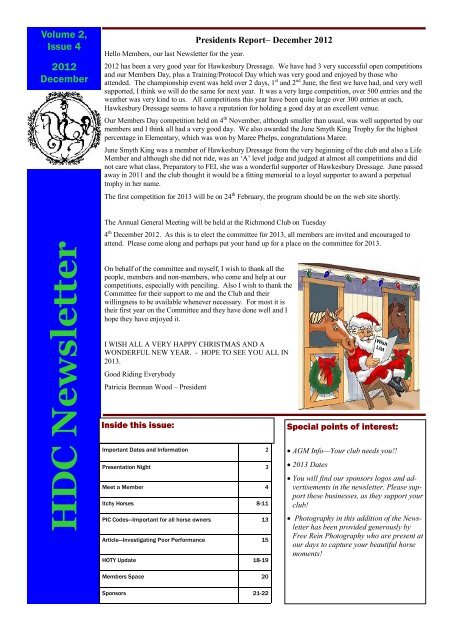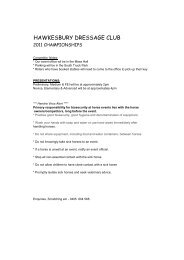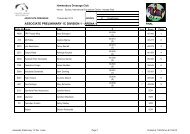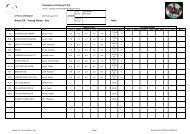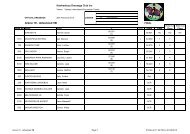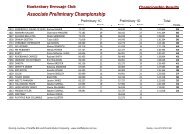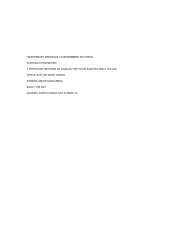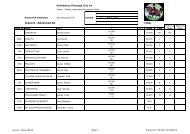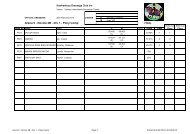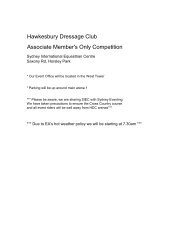December 2012 Newsletter - Hawkesbury Dressage Club Inc
December 2012 Newsletter - Hawkesbury Dressage Club Inc
December 2012 Newsletter - Hawkesbury Dressage Club Inc
Create successful ePaper yourself
Turn your PDF publications into a flip-book with our unique Google optimized e-Paper software.
HDC <strong>Newsletter</strong><br />
Volume 2,<br />
Issue 4<br />
<strong>2012</strong><br />
<strong>December</strong><br />
Hello Members, our last <strong>Newsletter</strong> for the year.<br />
Presidents Report– <strong>December</strong> <strong>2012</strong><br />
<strong>2012</strong> has been a very good year for <strong>Hawkesbury</strong> <strong>Dressage</strong>. We have had 3 very successful open competitions<br />
and our Members Day, plus a Training/Protocol Day which was very good and enjoyed by those who<br />
attended. The championship event was held over 2 days, 1 st and 2 nd June, the first we have had, and very well<br />
supported, I think we will do the same for next year. It was a very large competition, over 500 entries and the<br />
weather was very kind to us. All competitions this year have been quite large over 300 entries at each,<br />
<strong>Hawkesbury</strong> <strong>Dressage</strong> seems to have a reputation for holding a good day at an excellent venue.<br />
Our Members Day competition held on 4 th November, although smaller than usual, was well supported by our<br />
members and I think all had a very good day. We also awarded the June Smyth King Trophy for the highest<br />
percentage in Elementary, which was won by Maree Phelps, congratulations Maree.<br />
June Smyth King was a member of <strong>Hawkesbury</strong> <strong>Dressage</strong> from the very beginning of the club and also a Life<br />
Member and although she did not ride, was an ‘A’ level judge and judged at almost all competitions and did<br />
not care what class, Preparatory to FEI, she was a wonderful supporter of <strong>Hawkesbury</strong> <strong>Dressage</strong>. June passed<br />
away in 2011 and the club thought it would be a fitting memorial to a loyal supporter to award a perpetual<br />
trophy in her name.<br />
The first competition for 2013 will be on 24 th February, the program should be on the web site shortly.<br />
The Annual General Meeting will be held at the Richmond <strong>Club</strong> on Tuesday<br />
4 th <strong>December</strong> <strong>2012</strong>. As this is to elect the committee for 2013, all members are invited and encouraged to<br />
attend. Please come along and perhaps put your hand up for a place on the committee for 2013.<br />
On behalf of the committee and myself, I wish to thank all the<br />
people, members and non-members, who come and help at our<br />
competitions, especially with penciling. Also I wish to thank the<br />
Committee for their support to me and the <strong>Club</strong> and their<br />
willingness to be available whenever necessary. For most it is<br />
their first year on the Committee and they have done well and I<br />
hope they have enjoyed it.<br />
I WISH ALL A VERY HAPPY CHRISTMAS AND A<br />
WONDERFUL NEW YEAR. - HOPE TO SEE YOU ALL IN<br />
2013.<br />
Good Riding Everybody<br />
Patricia Brennan Wood – President<br />
Inside this issue:<br />
Special points of interest:<br />
Important Dates and Information 2<br />
Presentation Night 3<br />
Meet a Member 4<br />
Itchy Horses 8-11<br />
PIC Codes—Important for all horse owners 13<br />
Article—Investigating Poor Performance 15<br />
HOTY Update 18-19<br />
AGM Info—Your club needs you!!<br />
2013 Dates<br />
You will find our sponsors logos and advertisements<br />
in the newsletter. Please support<br />
these businesses, as they support your<br />
club!<br />
Photography in this addition of the <strong>Newsletter</strong><br />
has been provided generously by<br />
Free Rein Photography who are present at<br />
our days to capture your beautiful horse<br />
moments!<br />
Members Space 20<br />
Sponsors 21-22
Diary Dates<br />
H AWK ES BURY D RES SAGE<br />
CL UB<br />
‘For the sake of the horse’<br />
<strong>Newsletter</strong> Editor<br />
Leanne Bell<br />
432 The Driftway<br />
Londonderry 2753<br />
Email Leanne:<br />
bellbrae@iinet.net.au<br />
<br />
<br />
AGM – <strong>December</strong> 4th<br />
Competition Dates 2013<br />
February 24th<br />
June 1st/2nd<br />
August 4th<br />
November 3rd<br />
Meeting Dates <strong>2012</strong><br />
January—date to be confirmed with the club<br />
Meetings are held at the Richmond <strong>Club</strong> at 7:30pm each month. Some<br />
of us get there a bit earlier for a social chat over dinner at 6:30pm.<br />
If you would like to come along, we would love to see you there!!!<br />
Got something for the <strong>Newsletter</strong>?<br />
We would love to<br />
include your news, your<br />
items for sale, any hints and<br />
tips you may want to share<br />
with fellow members!<br />
This is YOUR newsletter—<br />
so feel free to send through<br />
any inclusions/<br />
ideas/feedback or comments<br />
to Leanne<br />
Find us on the website<br />
www.hawkesburydressage.com.au<br />
<strong>2012</strong> Committee<br />
President: Trish Brennan-Wood<br />
Vice-President: Sarah Ingall<br />
Secretary: Sally-Ann Barbera<br />
Treasurer/Public Officer: Stephanie McCully<br />
SIEC Liason: Maree Phelps<br />
Membership Coordinator: Karen Allan<br />
Sponsorship/Championship Coordinator: Christine<br />
Harbridge<br />
Newletter Editor: Leanne Bell<br />
Webmster: Sarah Ingall<br />
HOTY Coordinator: Maree Phelps<br />
Publicity Officer: Christine Harbridge<br />
Judges/Pencillers Gifts: Penny Callum<br />
Committee Members: Marcia Lewis, Joanne<br />
Peet, Leanne Bell, Nicole Pullen<br />
Events Secretary: Libby Campbell<br />
Page 2<br />
HDC N EW SLE TT ER
AGM and Presentation Night<br />
Tuesday <strong>December</strong> 4th<br />
7.30pm<br />
The Richmond <strong>Club</strong><br />
Finger Foods provided<br />
HOTY awards presentation<br />
Everyone Welcome!<br />
RSVP on the HDC Facebook page<br />
or contact Sally Barbera
Meet a Member—Sandi Oh<br />
Q: How long have you been riding and have you always done dressage?<br />
I have been riding for just on 3 years from my very first riding lesson in September 2009!<br />
I’ve only ever competed in pony dressage, even though my pony is a talented jumper.<br />
My first ever competition was the <strong>Hawkesbury</strong> <strong>Dressage</strong> <strong>Club</strong><br />
“when you have<br />
those fantastic<br />
moments, they<br />
make all the<br />
hard work worth<br />
it- magic”<br />
show last year in June.<br />
Q: How many horses do you have? What are their names?<br />
One pony only! His name is ‘Tilson Park Micheal’, stable name<br />
Mousey<br />
Q: At what level do you usually compete?<br />
Preliminary/Novice.<br />
Q: How many times a week are you able to ride?<br />
Pony is worked 6 days/week.<br />
Q: What do you like most about riding dressage?<br />
Most importantly it is the partnership with the horse that I love.<br />
<strong>Dressage</strong> really appeals to me on the same level as playing a musical<br />
instrument; it is something that the more you know, the more you realise you have<br />
to learn, and when you have those fantastic moments, they make all the hard work worth<br />
it- magic!<br />
Q: What do you like least about riding dressage?<br />
Horns to signal beginning of test. So uncouth!<br />
Q: What is your next goal with your current<br />
competition horse?<br />
Reaching Elementary by the end of the year<br />
(rather steep given we’ve just done our first<br />
Novice) and reaching Medium at some point<br />
the following year…<br />
Q: Is there anyone in particular who inspires<br />
you and helps you with your riding?<br />
Lots of people! Most of all, my 2 fantastic<br />
coaches; Pamela Bode and Denise Rogan;<br />
they are both excellent, experienced<br />
coaches and offer endless encouragement and support. I always<br />
look forward to my lessons and simply could not do without them!<br />
Q: If you didn’t ride what would you do instead?<br />
Sleep?<br />
Q: What’s something non-horsey about you that we are not likely to know?<br />
I am a violinist! I teach lots of littlies to play the violin every day and I absolutely love it!<br />
Q: Anything else you would like to add?<br />
Photo: Free Rein Photography<br />
Yes! : To any potential sponsors: Ponies are where the next generation of riders are coming<br />
from- show your support for this upcoming sport!<br />
Page 4<br />
HDC NE WSLE TTE R
VOLUME 2, IS SUE 4 Page 5
VOLUME 2, IS SUE 4 Page 6
Competition Pics—Members Day November 4th<br />
Congratulations to Maree Phelps on winning the Inaugural June-Smyth-King<br />
Award.<br />
Members Day results:<br />
Members day result scan be found on the HDC website, on the Competitions page<br />
VOLUME 2, IS SUE 4 Page 12
Competition Pics - November 4th <strong>2012</strong><br />
All photos generously supplied by Free Rein Photography<br />
VOLUME 2, IS SUE 4 Page 13
Equestrian Calendar and Directory—2013<br />
Hills & <strong>Hawkesbury</strong> Equestrian News have launched an Equestrian<br />
Calendar and Directory for 2013 as the equestrian community have<br />
said they don't have any one location to identify services in our<br />
area. HHEN will distribute 10,000 of these throughout the area,<br />
pertinent to Hills & <strong>Hawkesbury</strong> small businesses.<br />
There are display advertisements if you are interested and discounts<br />
available to those who book multiple advertisements.<br />
Please fill in the form on the next page and send back to us at your<br />
earliest.<br />
Camille Alexander<br />
Editor and Advertising Sales<br />
Hills and <strong>Hawkesbury</strong> Equestrian News<br />
Phone/Fax 02 4572 8860<br />
Mobile 0401 783 434<br />
VOLUME 2, IS SUE 4 Page 14
ABN: 30 540 143 670<br />
published by Almanac<br />
Mail: PO Box 237 Glenorie NSW 2157 Phone/fax: 02 4572 8860 Email: hillshawkesburyequestriannews@mail.com<br />
2013 Equestrian Calendar & Directory<br />
Advertising Booking Form<br />
Advertiser Name ____________________________ABN ____________________<br />
Contact Name ____________________ Email ____________________________<br />
Contact Phone ______________________ Mobile _________________________<br />
Billing Address ______________________________________________________<br />
Display advert $200 incl gst Display advert x 3 gain a free directory listing<br />
Directory Listing $100 incl gst Association/<strong>Club</strong> $55 incl gst<br />
Total value of Directory invoice $ ______<br />
Category _____________<br />
Name of Business _____________________________________________<br />
Phone /Mobile _______________________________________________<br />
Email /Web __________________________________________________<br />
Description of business/service provided<br />
___________________________________________________________________<br />
___________________________________________________________________<br />
___________________________________________________________________<br />
LOGO - provided Yes No<br />
PAYMENT VISA Mastercard Direct Deposit<br />
Name on Card ________________________________<br />
Exp Date _ _ / _ _<br />
Card Number _ _ _ _ / _ _ _ _ / _ _ _ _ / _ _ _ _<br />
Amount ______________<br />
Direct Deposit: Bendigo Bank Account Name: Almanac BSB# 633 000 A/C # 143 680 742<br />
Please quote invoice # or name of advertising account
Investigating Poor Performance— Part 2<br />
Author: Monique Batterham<br />
Author: Monique Batterham<br />
Certified Equine Sports Therapist (CertEST)<br />
Australian College of Animal Tactile Therapy (ACATT)<br />
Part 1 of this article can be found in the August edition of the HDC <strong>Newsletter</strong>—see website<br />
Detailed Physical Examination<br />
A veterinary inspection can involve a number of tests as detailed below.<br />
Heart<br />
The heart forms part of the cardiovascular system which is responsible for pumping oxygenated and nutrient<br />
rich blood around the body to the muscles and organs where it is required. Therefore if the heart is<br />
not working as required, the body will not be receiving the oxygen and nutrients it requires.<br />
According to Dr. Herb Maisenbacher, clinical assistant professor of cardiology at the University of Central<br />
Florida College of Veterinary Medicine, heart disease is the third most common cause of poor performance<br />
in horses, after musculoskeletal and respiratory challenges (Pomeroy 2009). And of the heart conditions<br />
found in horses, the most common heart problem is an arrhythmia (irregular heart beat or atrial fibrillation)<br />
(Pomeroy 2009). With atrial fibrillation, the electrical activity of the top chambers of the heart<br />
(atria) is uncoordinated. This results in reduced pumping of blood to the ventricles, as well as an irregular<br />
ventricular rhythm. The resulting reduced cardiac output can cause poor performance.<br />
A vet check can detect this, or any other heart abnormalities.<br />
Lungs<br />
The respiratory system is responsible for delivering oxygen to the lungs at which point the oxygen can diffuse<br />
via the alveoli into the blood and the carbon dioxide can undergo the reverse process moving out of<br />
the blood into the lungs to be exhaled. This process is known as gas exchange.<br />
Oxygen is required by the muscles for aerobic activity, and during exercise the horse is required to inhale<br />
enormous volumes to supply the muscles, as evidenced by the fact that the oxygen consumption increases<br />
by as much as 35 times during exercise as compared to resting (Clayton 1991). After lameness,<br />
respiratory problems are the most common cause of loss of performance (Marlin and Nankervis 2002).<br />
Therefore any problem with the lungs will result in a flow-on effect to performance. Dust poses a major<br />
problem for horses, with the stabling of horses being the biggest culprit. One study of seemingly healthy<br />
horses of all ages housed in conventional stables found that all of them had microscopic evidence of inflammatory<br />
airway disease (Gerber, Robinson, Luethi 2003).<br />
Another condition, exercise induced pulmonary hemorrhage (EIPH) is a condition that can affect the lungs<br />
as the horse bleeds resulting in blood in the lungs. According to research by the Washington State University<br />
(Bayly), the placing of 100ml of blood into the lungs negatively effected the horses' ability to perform<br />
at a high-speed gallop on a treadmill due to interference with the movement of oxygen from the lungs<br />
into the blood supply meaning less oxygen was available for their muscles to use. The fact that somewhere<br />
between 40 and 75% of thoroughbred racehorses have been found with blood in their trachea after<br />
racing (Marlin 2002), demonstrates how large of a problem this is amongst performance horses.<br />
Continued next page…..<br />
Page 17<br />
HDC NE WSLE TTE R
Investigating Poor Performance— Part 2<br />
The lungs can be inspected via:<br />
<br />
<br />
<br />
stethoscope to listen for any abnormalities;<br />
exercise testing (e.g. VO 2max ); and<br />
endoscopy (discussed in detail below).<br />
Digestive System<br />
Performance relies on having the right and adequate levels of fuel, i.e. ADP, which coverts chemical energy<br />
produced by the horse’s consumption of carbohydrates, proteins and fats into kinetic energy. So<br />
when there is a problem with the digestive system the horse will not receive adequate chemical energy.<br />
In addition for the various biological systems to work adequately requires the right nutrients, for instance<br />
iron for the blood to ensure it has adequate oxygen carrying capacity, insufficient iron will directly relate to<br />
a performance deterioration.<br />
Signs that something is wrong with the digestive system:<br />
coat condition;<br />
weight loss;<br />
leaving feed;<br />
hooves (e.g. rings and general condition of hooves); and<br />
manure (e.g. too wet could mean food passing through digestive tract too quickly).<br />
The vet can check gut sounds and also through blood work the vet can tell how well the liver and kidney is<br />
functioning. The vet can also use an endoscope to view the oesophagus and stomach, although the small<br />
and large intestines are too long to attempt to scope. There are also kits that can be used to test for blood<br />
and protein in the horse’s faeces which can be a sign of a GI tract condition, e.g. stomach ulcers<br />
(Freedom Health 2011).<br />
Lameness<br />
Lameness can affect performance as the pain will cause the horse to slow down. Lameness will be apparent<br />
at either the walk, trot or both. Through sight (assessing the horse for head bobbing and unevenness<br />
in gait) and sound (listening to the foot falls on a hard surface) will help detect and isolate the leg involved.<br />
The vet is able to conduct an investigation to determine the cause of the lameness, such as using<br />
hoof testers to determine if the pain is originating in the hoof. Procedures, including nerve blocks, radiography<br />
and ultrasound, can be utilised by the vet to detect navicular syndrome, bone fractures or muscle,<br />
tendon or ligament damage. Generally the nerve block can detect the general region within the limb, and<br />
then radiography and ultrasound are used to ascertain the exact cause.<br />
Electrocardiogram<br />
An electrocardiogram (ECG) is a record of the electrical activity of the heart during the different phases of<br />
the cardiac cycle graphed as voltage against time (Clayton 1991).<br />
An ECG can help detect heart abnormalities such as cardiac arrhythmias and conduction disturbances<br />
and heart disease. It does this by providing information on the pattern of electrical conduction, or the<br />
electrical impulses that trigger the heart chambers to contract with perfectly synchronized timing. <br />
The ECG records this electrical activity and depicts it as a series of graph-like tracings, or waves. The<br />
shapes and frequencies of these tracings reveal abnormalities in the heart's anatomy or function.<br />
An ECG would be used where there was a concern of any abnormality arising from listening the heart via<br />
a stethoscope.<br />
Continued next page…..<br />
Page 18<br />
HDC NE WSLE TTE R
Investigating Poor Performance— Part 2<br />
Endoscopy<br />
Endoscopy involves placeing a scope down the horse’s airways. Videoendoscopy allows the recording of<br />
the findings. Apart from performance issues, endoscopy may be used as a pre-purchase screening test,<br />
or if the horse is showing signs of nasal discharge, nosebleeds, unusual noises, excessive coughing or<br />
swelling of the head or neck.<br />
Endoscopy allows the vet to detect any abnormalities within the upper airway tract and can be performed<br />
either on the horse at rest or with the horse exercising on the treadmill.<br />
At rest the following can be detected via an endoscopy:<br />
structural abnormalities in either nasal passage;<br />
epiglottic entrapment;<br />
laryngeal hemiplegia (“roaring”);<br />
dorsal displacement of the soft palate (DDSP); and<br />
granuloma of the arytenoid (chronic inflammatory lesion).<br />
During a treadmill test the following can be detected in addition to the above:<br />
epiglottic reversion (an epiglottis that is flipping backwards); and<br />
axial deviation of the aryepiglottic folds (tissue spanning from the arytenoid to the epiglottis that collapses<br />
across the opening to the trachea)<br />
Also DDSP can be easier to detect during exercise since it can be intermittent.<br />
Exercise Testing<br />
The above tests would typically detect the majority of causes of poor performance. If no abnormalities<br />
were detected, exercise testing would be recommended. Exercise testing can also used to determine a<br />
horse’s potential or to monitor fitness and the effects of training.<br />
Two fundamental factors with exercise testing is ensuring standardisation<br />
to enable comparability as well as taking into account<br />
environmental factors, for instance heart rates can be impacted<br />
by environmental factors up to 110 beats per minutes (Scully<br />
2006), therefore any testing needs to be done above this level,<br />
which is why V 140 and V 200 are popular levels to test at.<br />
Considering this, treadmill testing is deemed more favourable as<br />
it is easier to control variables than for field work and it also enables<br />
more equipment to be utilised, e.g. endoscopy. The disadvantage<br />
is that it does not replicate the conditions the horse experiences<br />
in competition, however inclining the treadmill to 6 0 can<br />
help overcome this (Scully 2006).<br />
Continued next page…..<br />
Page 19<br />
HDC NE WSLE TTE R
Investigating Poor Performance— Part 2<br />
Measurements taken during an exercise test can include:<br />
Heart Rate – looking at V 140 and V 200 , can test fitness levels with higher levels indicating an increase in<br />
fitness (i.e. can move faster whilst the heart has to do less work). Average speed at which V 200 is<br />
reached is 8.5 – 10 m/sec. 10 m/sec and above is considered to be an elite athlete (Scully 2006).<br />
Blood lactate measurements – gives an indication of aerobic capacity since the horse only produces<br />
lactic acid when unable to utilise aerobic metabolism and shifts to anaerobic. V LA4 measures the<br />
speed at which the blood lactate reaches 4mmol/l. The greater the V LA4 – the greater the fitness<br />
and exercise capacity.<br />
Arterial Blood Gases (ABG) – used to measure hypoxaemia (insufficient oxygenation of arterial blood).<br />
Total Red Cell Volume to Total Blood Volume – provides an indication of oxygen carrying capacity.<br />
Normal values are 78 – 102 ml/kg of bodyweight (Scully 2006).<br />
Post Exercise PCV – gives a measurement of the total red cells in the circulation, which is an indication<br />
of the oxygen carrying capacity.<br />
Oxygen uptake and CO2 output – measured with a facial mask, the O 2 inspired is compared to that<br />
expired. O 2 uptake plotted against speed to calculate VO 2max as it as a linear relationship. VO 2max<br />
gives an indication of aerobic capacity.<br />
Conclusion<br />
Determining the cause of a horse’s poor performance involves an assessment of the symptoms, history of<br />
the horse and an investigation into more recent changes in the day-to-day management and training of<br />
the horse. This analysis can give clues into the likely causes and then it is a process of elimination to determine<br />
what the underlying cause or causes may be. As equine sports therapists our role is to best understand<br />
the various underlying factors and provide the best advice possible to our clients to help detect<br />
the cause, and then help the client manage and return the horse to optimum performance levels.<br />
Page 20<br />
HDC NE WSLE TTE R
Members Space<br />
Product Review<br />
Members can submit favourite products here—share your “super product” - what can you just not do without in your tack room?<br />
Waiting for member input……..<br />
Book Review<br />
Waiting for Member input<br />
Waiting for member input<br />
What is your favourite book?<br />
<strong>Inc</strong>lude it here in the next<br />
edition!<br />
Members Space<br />
Members can submit items of news<br />
here—anything at all !!<br />
Perhaps a great achievement with your<br />
horse, an inspirational quote, horses for<br />
sale, lease, items for sale, competition<br />
results, anything at all that you would<br />
like to share with fellow members.<br />
WANTED:<br />
I am looking to lease, possible purchase a prospective second international horse<br />
with the prospect of going to WEG and Rio with the Para Equestrians. I am a grade<br />
IV Para rider so looking for quiet, sound and unflappable<br />
Please contact Kaye Hannan<br />
0448 094 151<br />
SURVEY:<br />
This survey is designed to help us learn more about the views we have about mares, geldings and stallions and what<br />
we’d choose when considering horses for various disciplines. Furthermore, we are also seeking data on what we look<br />
for when choosing an ideal horse. We have had a great response (>500 responses) but would love to hear from as<br />
many horse riders and owners as we possibly can. Feel free to pass it on to friends or family, everyone’s opinion<br />
helps it doesn't matter if you have never ridden a horse in your life - we would still love you to complete a survey!<br />
Some of the questions may seem overly simplistic if you’ve been around horses for a while, but there are opportunities<br />
to explain your views.<br />
It’s a short survey with simple, easy to answer questions. Responses are completely anonymous .<br />
https://www.surveymonkey.com/s/GFJV3XT<br />
Many thanks, Kandoo Equine<br />
Page 21<br />
HDC NE WSLE TTE R
VOLUME 2, IS SUE 4 Page 22
VOLUME 2, IS SUE 4<br />
Page 23


